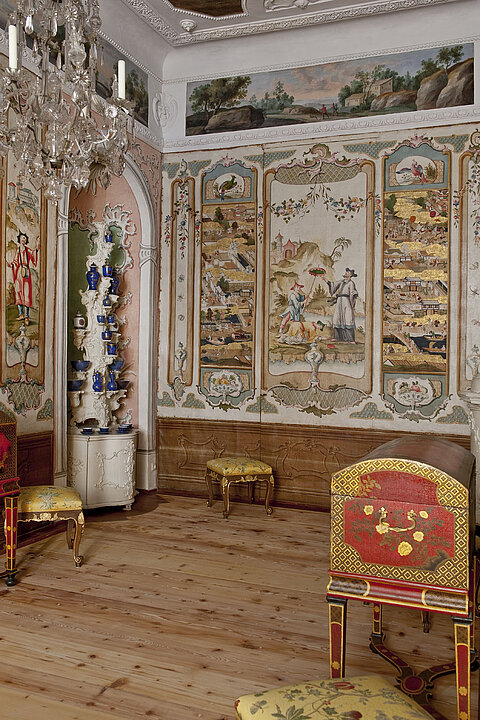Europe was already fascinated by the alien beauty of East Asian craftsmanship in the 16th century. Chinese porcelain, silk paintings and Japanese lacquered work soon became very popular. Johann Seyfried von Eggenberg bought a number of exotic treasures of this kind between 1660 and 1680, in the course of a lavish refurbishing of the princely residences in Eggenberg and Graz, including a screen ‘laid with Indian paper’, which was already in the family Palais in Graz pre-1700. When the Eggenberg state rooms were refurbished again post-1754, this old screen was taken apart and inserted into the wall-covering of a fashionable ‘Japanese cabinet’ as exotic decoration. However, after the Eggenberg family died out in 1774, knowledge about the origin of this work of art was lost. It was that circumstance that led to the screen surviving unrecognised in Schloss Eggenberg so long.
The Ôsaka Folding Screen
Discovery of a Japanese rarity at Schloss Eggenberg
A sensational discovery
From time to time, Japanese works of art are discovered in Europe that one can describe without exaggeration as sensational. One of these is a fascinating early 17th-century Japanese folding screen with scenes of Osaka (Jap. Osaka zu byôbu), which survived unrecognised for over 250 years as wall decoration in the Japanese Cabinet at Schloss Eggenberg.
Only after restoration of the room in 2001-2004 was it recognised that the East Asiatic pictorial features of the Rococo wall-covering were actually sections of an eight-fold, early 17th-century Japanese screen taken apart in Europe. Pieced together again, the panels form a coherent painting with a unique and hitherto unknown veduta of the castle and “castle town” (jôkamachi) of Osaka pre-1615.
A unique testimony
The discovery of the screen almost 250 years later was a sensation even in Japan. In 2007, a joint research project was set up with Kansai University of Osaka, the University of Cologne and the Joanneum Universal Museum that has already brought to light a wealth of information about the screen.
The Eggenberg screen has provided new insight into a critical phase in Japanese history. After a century of brutal civil wars and destruction, the country experienced a period of resurgence and economic and cultural revival under the famous general and unifying figure of TOYOTOMI Hideyoshi (1536-1598). Hideyoshi built up Osaka as an economic metropolis, and constructed the huge castle of Osaka as a visible symbol of his power, which European missionaries described as a wonder of the world. However, the city’s heyday only lasted a few decades. After Hideyoshi’s death, the Toyotomi faction was defeated by the army of the Tokugawa at the famous siege of Osaka in summer 1615. The Tokugawa subsequently ruled Japan for over 250 years. The defeat led to the total destruction of the castle and city of Osaka and the wiping out of the Toyotomi family. Nothing was to remain to remind anyone of this ‘Golden Age of Japan’. Almost all works of art and documents that bore witness to the power and brilliance of Toyotomi rule were destroyed. The Eggenberg screen, which so miraculously survived in Europe, is a unique testimony to the lost metropolis.
The Osaka zu byôbu (screen with scene of Osaka) offers a fascinating trip through what was once Japan’s most brilliant castle, and at the same time a monumental palace and unconquerable fortress. It also provides glimpses of the life of the warrior class (samurai houses) at the Toyotomi court, and the everyday lives of rich merchants and craftsmen in the civilian city, palaces of the feudal lords, temples and Shinto shrines.
The Eggenberg screen was widely publicised during public symposia in Osaka (2007), Graz and Tokyo (2008). The Graz session focused on examining the original, followed by expert discussion in the presence of the work at Schloss Eggenberg. The aim was to clarify how the work was bought and transported, the dating, identity of the artists, details of content, materials and technique, plus the important question of how the sensitive item should be treated in future.
Trip through Osaka
Start the trip by clicking on the first picture.
Partnership agreement between Schloss Eggenberg and Osaka Castle
On the occasion of the Austrian President’s state visit to Japan in 2009, the Joanneum management concluded a sister great-house partnership agreement between Schloss Eggenberg and Osaka Castle. The partnership set the seal on the close collaboration and scholarly links between Japanese museums and the Joanneum Universal Museum, and will facilitate reciprocal exhibition projects.
Eggenberg is incidentally the only great house outside Japan which has been accorded the honour of such a ‘sister great house’ partnership.

Image Credits

Image Credits

Image Credits





















